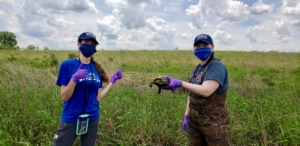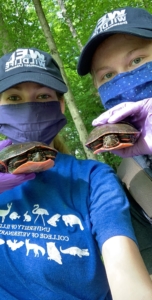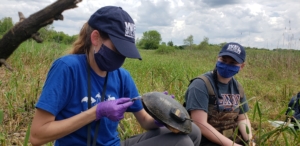
First Blanding’s turtle of the season.
After almost two weeks of preparation, (and months longer of building excitement), this week we made it to the field. We were given the address of our worksite, two genuine WEL hats and we were off. We loaded the car up on Wednesday, moved to the site and set up our lab. Thursday and Friday we were out in the marshes. Luckily, we were not left to our own devices the first few days out. We were joined by the amazing Dr. Laura Adamovicz, who gave us a crash course in turtle health assessment and sampling techniques. We were guided by members of the awesome Forest Preserve team who took us to the sites and helped locate the turtles via traps and radio telemetry. Even though we have only spent two days in the field, there were two very steep learning curves we quickly discovered.
 The first main obstacle we were not prepared to deal with were the mosquitoes at particular sites. We wore bug spray, protective clothing, and smacked any bugs we saw on each other to no avail. Michelle proudly sports 49 mosquito bites to date, while Alexis wins the grand prize for a total of 291 bites. Michelle is not typically food of choice for insects so she has never had so many bites before at once and is quote, “probably dying”. Meanwhile Alexis is a weathered veteran of living as a bug buffet so she just slathers anti-itch cream like lotion and fights on. As we regroup and take stock of casualties, we strategize for the coming week. We’ve upgraded our arsenal of mosquito repellent to less forgiving chemicals and plan to wear more layers at the problem sites so the mosquitoes have a harder time biting through to skin. This week the mosquitoes won the battle, but we will win the war.
The first main obstacle we were not prepared to deal with were the mosquitoes at particular sites. We wore bug spray, protective clothing, and smacked any bugs we saw on each other to no avail. Michelle proudly sports 49 mosquito bites to date, while Alexis wins the grand prize for a total of 291 bites. Michelle is not typically food of choice for insects so she has never had so many bites before at once and is quote, “probably dying”. Meanwhile Alexis is a weathered veteran of living as a bug buffet so she just slathers anti-itch cream like lotion and fights on. As we regroup and take stock of casualties, we strategize for the coming week. We’ve upgraded our arsenal of mosquito repellent to less forgiving chemicals and plan to wear more layers at the problem sites so the mosquitoes have a harder time biting through to skin. This week the mosquitoes won the battle, but we will win the war.
 We learned a second valuable lesson this week while being taught venipuncture on turtles. It will take a while for us to hone our skills, and even once we are confident you can never garuntee a perfect draw. At this stage it is important to prioritize quality of sample over quantity. Not all the tests require the same type or quality of sample and we can use that to our advantage. We have quickly learned how to put an “imperfect sample” to use. Developing these decision-making skills is essential for our profession. Treating many species means adjusting to different anatomies so we will be “re-learning” how to draw blood for the duration of our careers. At some point you just have to do your best and draw your sample. Our abilities will be truly defined by how we adapt to each situation and how we respond to the “imperfect” samples.
We learned a second valuable lesson this week while being taught venipuncture on turtles. It will take a while for us to hone our skills, and even once we are confident you can never garuntee a perfect draw. At this stage it is important to prioritize quality of sample over quantity. Not all the tests require the same type or quality of sample and we can use that to our advantage. We have quickly learned how to put an “imperfect sample” to use. Developing these decision-making skills is essential for our profession. Treating many species means adjusting to different anatomies so we will be “re-learning” how to draw blood for the duration of our careers. At some point you just have to do your best and draw your sample. Our abilities will be truly defined by how we adapt to each situation and how we respond to the “imperfect” samples.
Stay tuned for more of our experiences and cute turtle pictures as we enter our first full week of field
